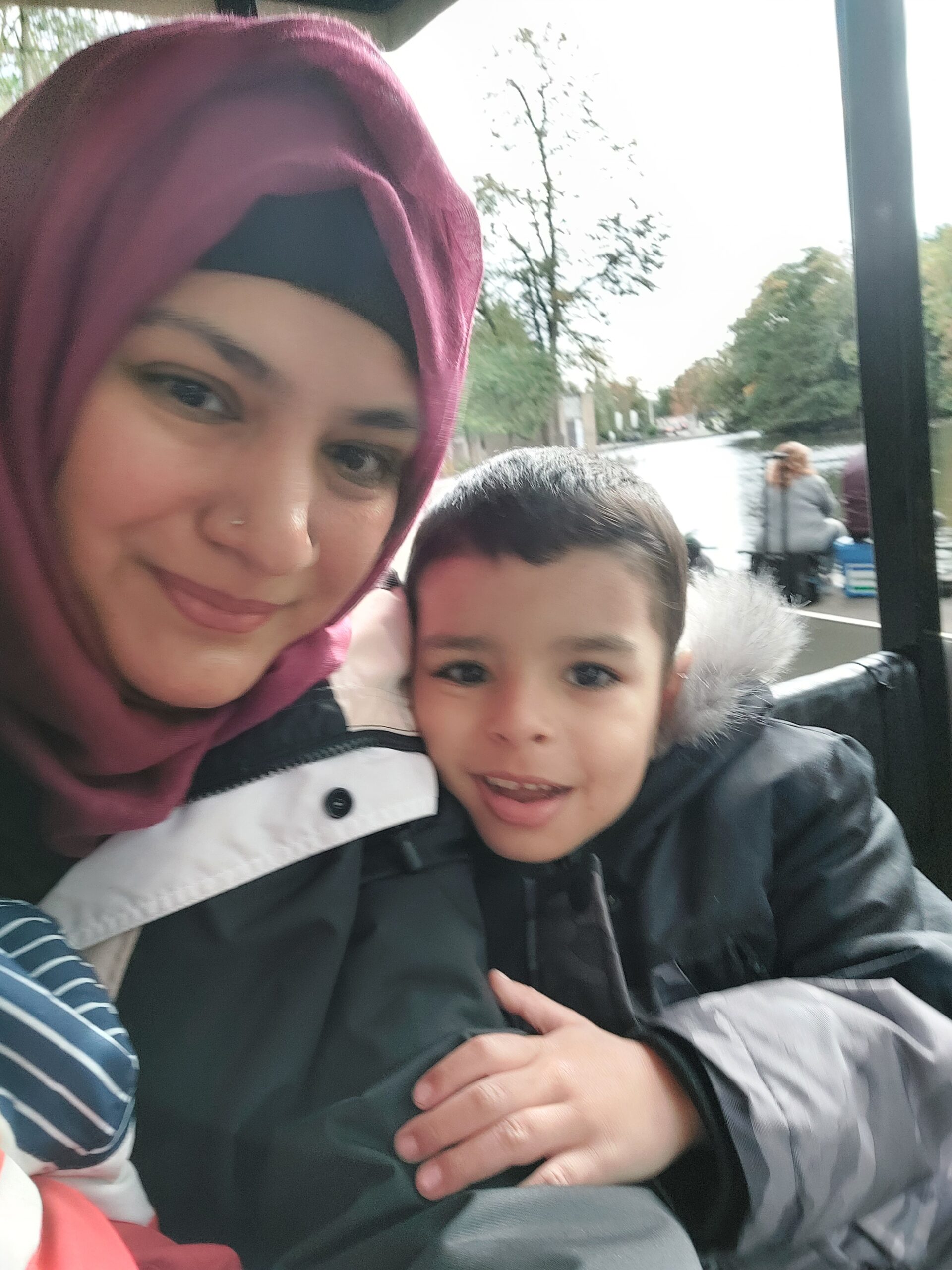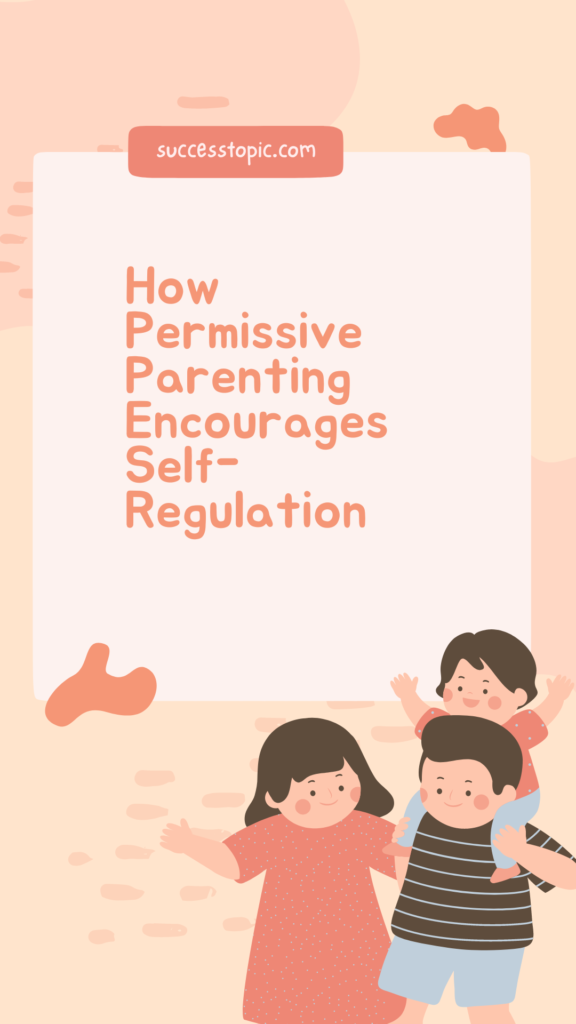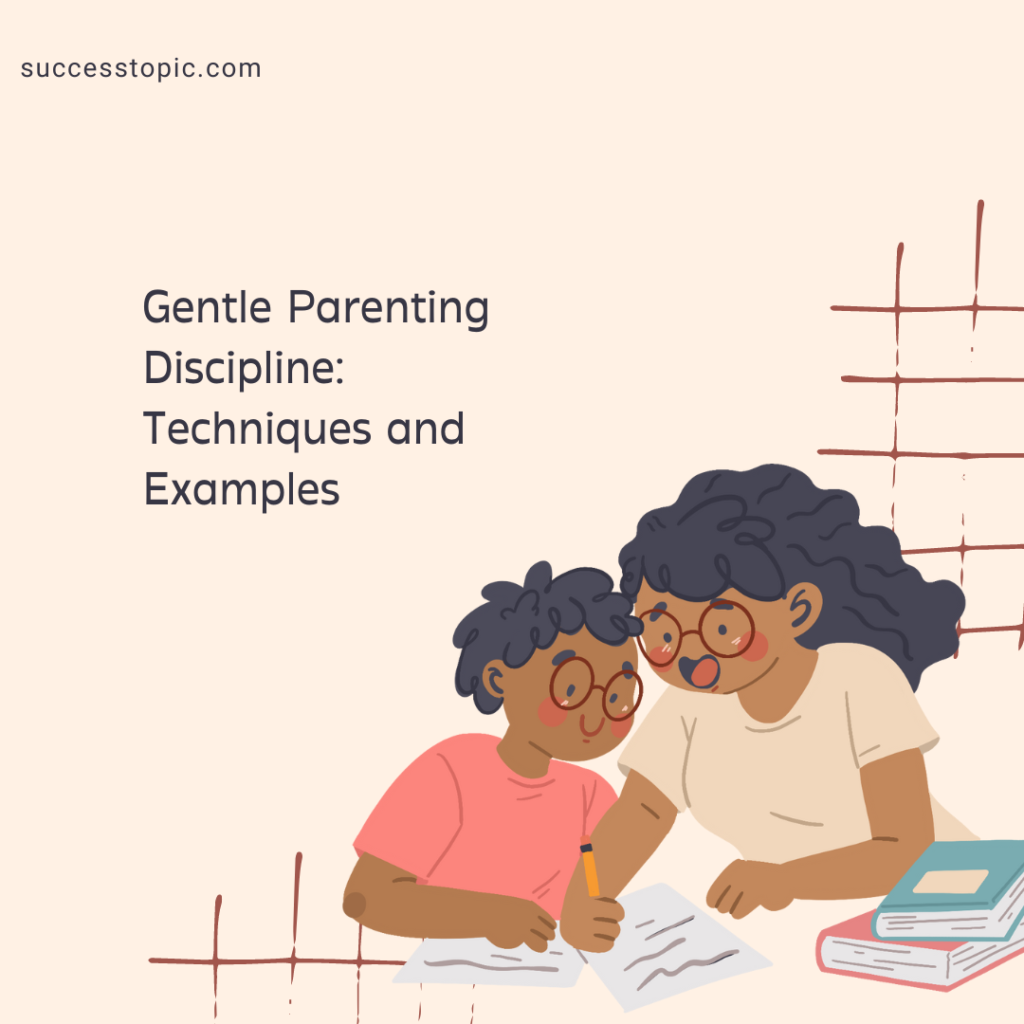
Gentle parenting is a parenting style that focuses on strengthening the bond between parent and child while also encouraging positive behavior through respectful communication and discipline. A cornerstone of this parenting style is gentle parenting discipline, but what exactly is it?
This article will define gentle parenting discipline, explain how it differs from other types of discipline, and provide examples of gentle parenting discipline techniques.
What is Gentle Parenting Discipline?
A gentle parenting discipline approach prioritizes positive reinforcement and nurturing over punishment and fear. Instead of controlling and punishing children, it is better to guide and teach them. Positive reinforcement, natural consequences, empathy and understanding, and redirecting are all examples of gentle parenting discipline techniques. Gentle parenting discipline aims to provide a safe, loving, and supportive environment for children to grow into happy, healthy adults.
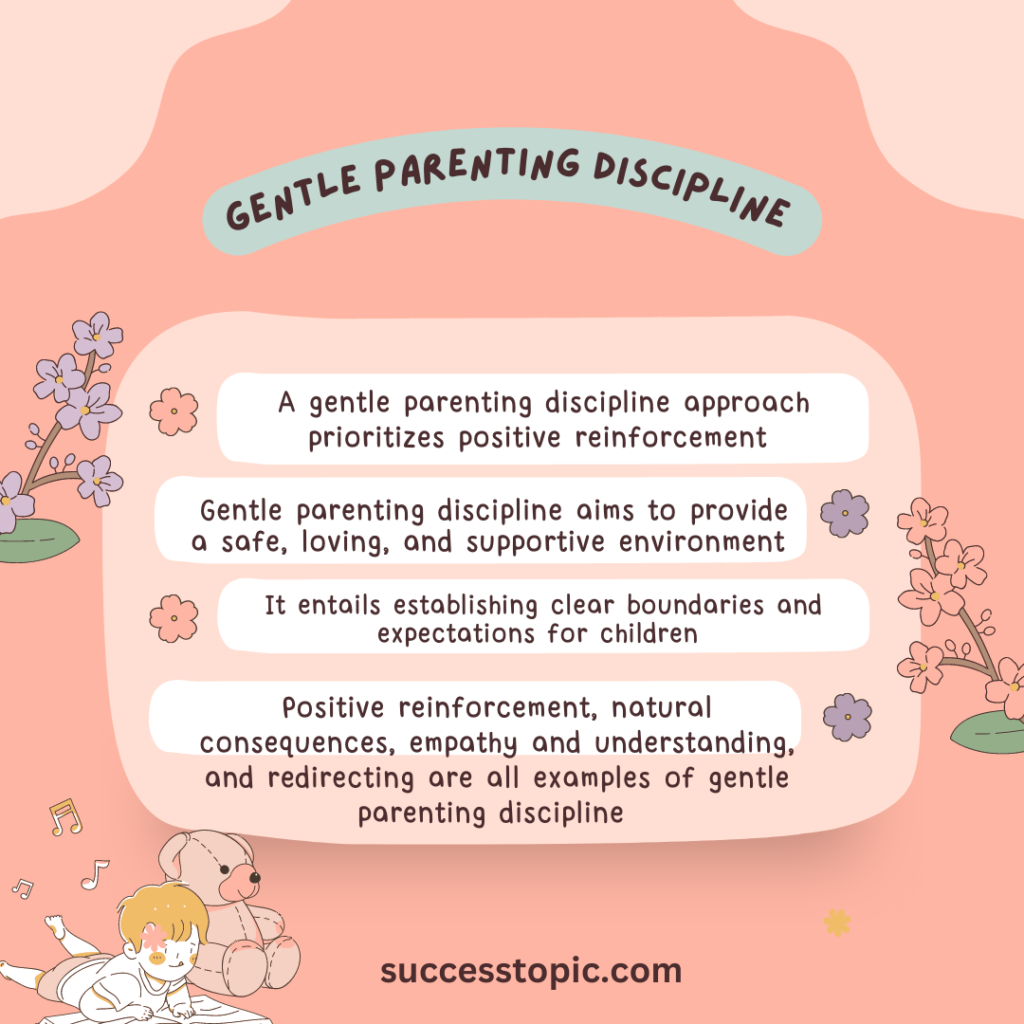
It entails establishing clear boundaries and expectations for children and providing them with the tools they need to meet those expectations. Gentle parenting discipline is based on the assumption that children are inherently good and that misbehavior is caused by unmet needs or a lack of understanding.
It is rooted in the belief that children deserve respect and empathy and that discipline should be used as a tool to teach and guide children rather than to control or dominate them.
What is Gentle Parenting?
Gentle parenting is a parenting style that prioritizes a child’s emotional and mental health. It entails treating children with dignity, empathy, and kindness and establishing clear boundaries and expectations. Gentle parenting does not imply permissive parenting or that children can do whatever they want. Rather, it entails providing guidance and support in a compassionate and empathetic manner.
Gentle parenting deals with both parents and children’s emotional and physical well-being. It emphasizes the importance of developing strong, loving relationships with children by listening to their needs, acknowledging their feelings, and responding with kindness and compassion. Gentle parenting entails treating children as individuals with empathy and understanding.

It is a parenting style emphasizing positive reinforcement and natural consequences over punishment and fear. Gentle parenting aims to provide a safe, nurturing environment where children can grow and thrive.
How to Discipline with Gentle Parenting?
When it comes to discipline, gentle parenting discipline encourages parents to use positive reinforcement and natural consequences rather than punishment. This means focusing on rewarding good behavior rather than punishing bad behavior and allowing children to experience the natural consequences of their actions rather than imposing arbitrary consequences.
Disciplining with gentle parenting involves using positive and respectful methods to guide children’s behavior. Here are some ways to gentle parenting discipline:
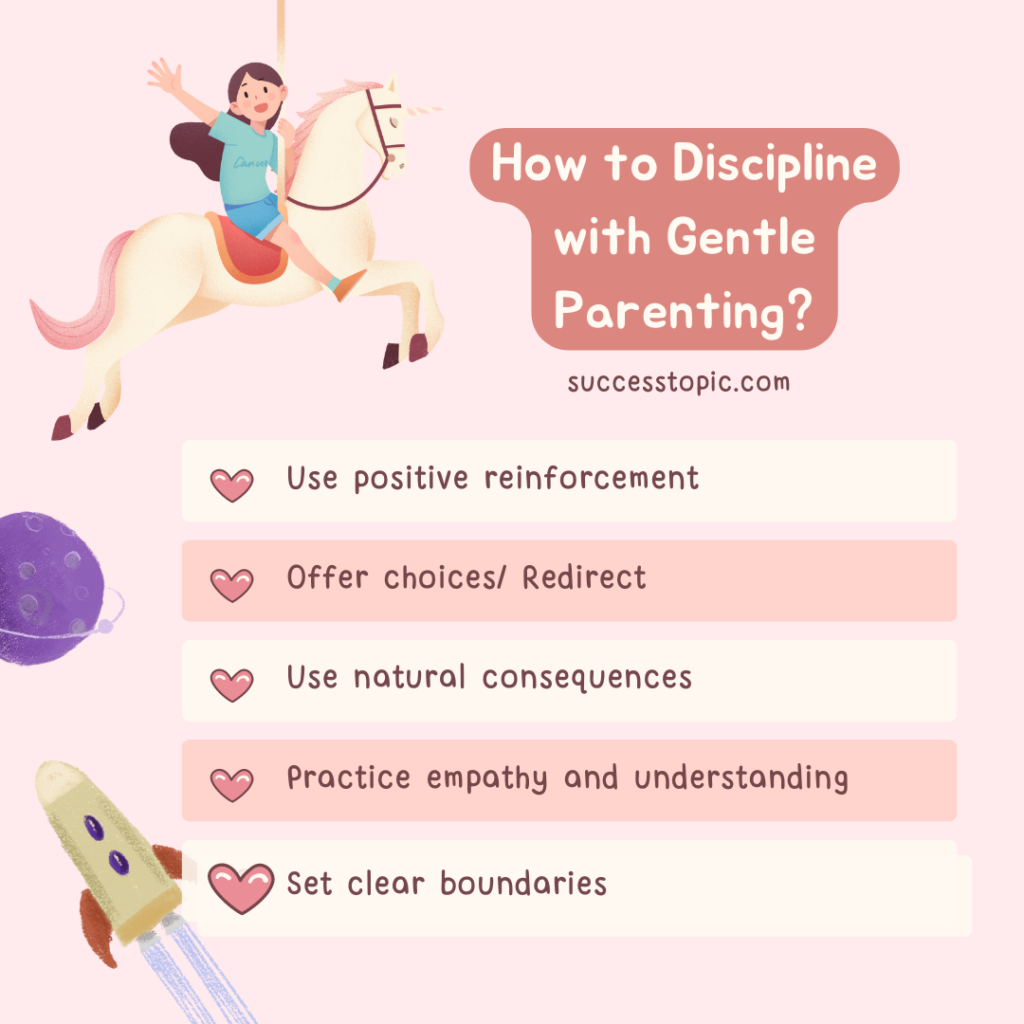
Use positive reinforcement
Instead of punishing bad behavior, reinforce positive behavior with praise and rewards.
Offer choices
Give children age-appropriate choices to help them feel like they have some control over their lives.
Use natural consequences
Allow your child to experience the natural consequences of their actions instead of imposing punishments.
Practice empathy and understanding.
Try to understand your child’s perspective and respond with empathy and compassion.
Redirect
Instead of saying “no” or “stop” all the time, redirect your child’s attention to another activity.
Set clear boundaries
Provide clear and consistent rules and boundaries for your child.
Practice positive communication
Use positive communication techniques like active listening to build a strong and respectful relationship with your child.
Remember, gentle parenting is about creating a safe and supportive environment for your child to learn and grow with love and respect.
Does Gentle Parenting mean no Discipline?
Some parents are concerned that gentle parenting will result in no discipline at all, but this is not the case. Gentle parenting discipline simply means using kind, respectful, and effective discipline. Instead of controlling and punishing children, it is better to guide and teach them.
According to Verywell Family gentle parenting discipline involves understanding a child’s feelings and responding in a way that benefits their emotional well-being. Gentle parenting discipline, as described by Verywell Family, uses positive and negative consequences and avoids power struggles, but it does not try to force children to do anything by sheer will.
The gentle parenting discipline is collaborative and focuses on teaching, as described by The Washington Post. Therefore, while gentle parenting does not involve harsh punishments or shaming, it still involves setting boundaries and guiding children’s behavior.
What are Gentle Parenting Discipline Techniques?
Positive Reinforcement
This technique focuses on praising and rewarding your child for good behavior.
For example, when your child shares their toys with their sibling, you can say, “I’m so proud of you for being kind and sharing your toys. That was really thoughtful.”
Why Positive reinforcement
Positive reinforcement is a technique in which desirable behavior is rewarded to increase the likelihood that the behavior will be repeated in the future. This technique provides a positive consequence immediately after a desired behavior is displayed. The positive consequence can be anything that is motivating or rewarding to the child. For instance, praise, a hug, a high-five, a small treat, or additional playtime can be positive reinforcements.
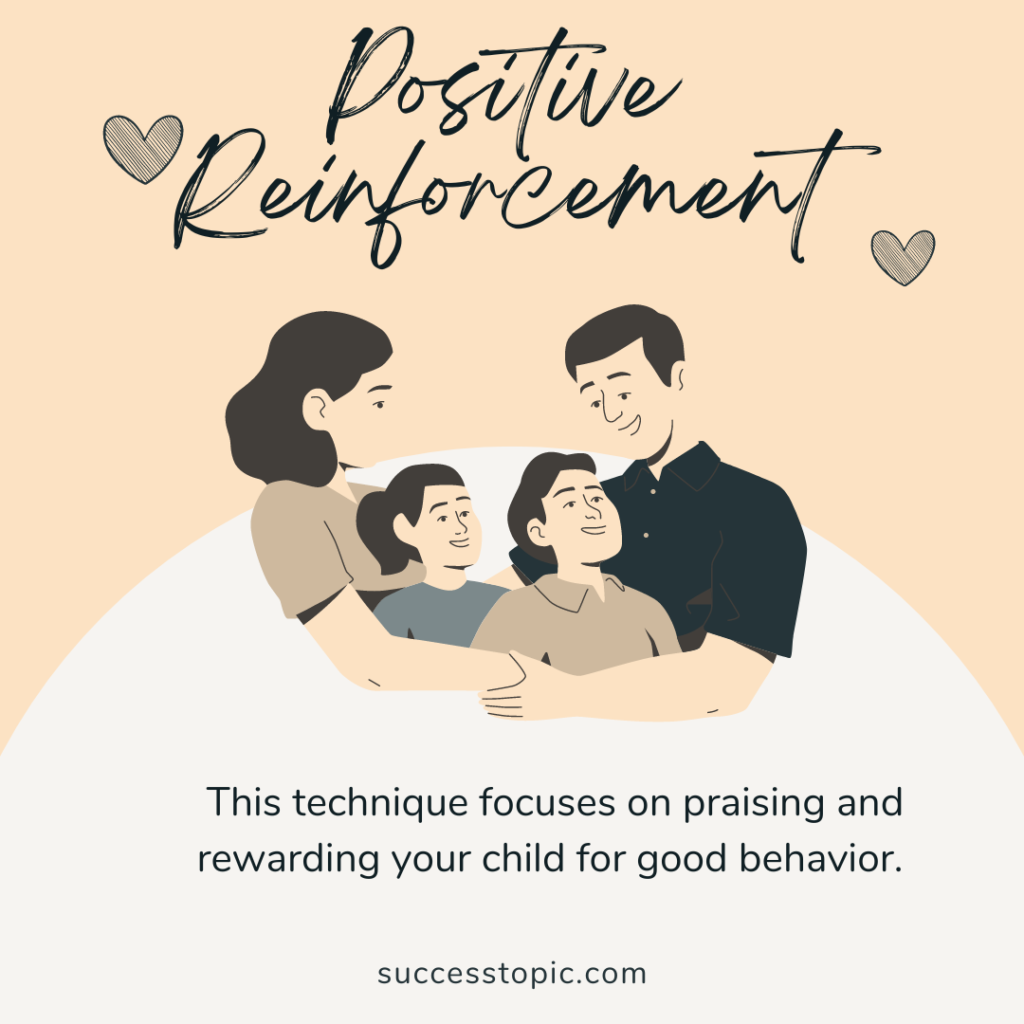
The key to effective positive reinforcement is to use it consistently and immediately after the desired behavior is displayed. This helps to create a connection between the behavior and the reward. Over time, the child will learn that engaging in the desired behavior leads to positive consequences, which increases the likelihood that they will continue to display the behavior.
Positive reinforcement is a powerful tool in shaping a child’s behavior. It is often used in combination with other gentle parenting discipline techniques, such as redirecting or natural consequences, to create a positive and supportive environment for the child to learn and grow.
Natural Consequences
Allowing your child to experience the consequences of their actions is part of this technique. If your child, for example, refuses to wear a coat outside, they may become cold and uncomfortable. You can relate to them by saying, “I know it’s cold outside, but you might get cold if you don’t wear your coat. Do you want to put it on right now?”
Natural consequences are outcomes that result from a child’s behavior or choices. Unlike punishment or negative consequences, natural consequences are not imposed by an adult but rather occur naturally due to the child’s actions. For example, if a child refuses to wear a coat on a cold day, they will naturally feel cold and possibly get sick, which is a natural consequence of their behavior.
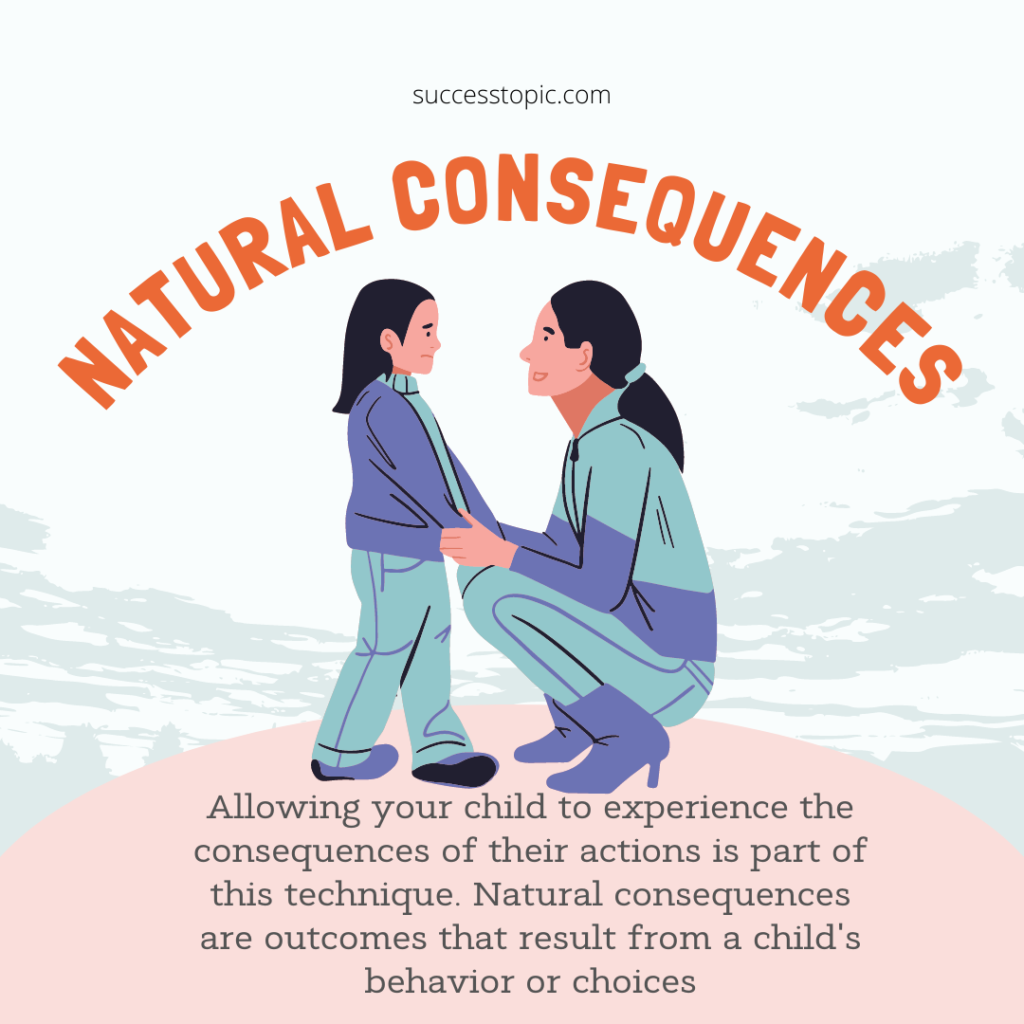
Why use natural consequences as a gentle parenting discipline technique
Using natural consequences as a gentle parenting discipline technique can be an effective way to help children learn from their mistakes and take responsibility for their actions. When natural consequences are allowed to occur, children have the opportunity to learn from their mistakes without feeling shamed or humiliated.
However, it is important to note that natural consequences should only be used when they are safe and appropriate for the child. In situations where the natural consequences could be harmful or dangerous, the parent or caregiver must step in and provide guidance or redirection.
In addition, when using natural consequences as a gentle parenting discipline, it is important to be empathetic and supportive. Children need to feel that their parents or caregivers understand their feelings and are there to help them learn and grow. By using natural consequences in a positive and supportive way, parents can help their children build strong decision-making skills and become more responsible individuals.
Time-In
Setting aside time to connect with your child when they are upset or misbehaving is part of this technique. Rather than putting them in time-out, you can sit with them and help them work through their emotions. If your child is crying because they didn’t get their way, you can say, “I can tell you’re upset. Could you explain why you’re feeling this way? Let us discuss it together.”
Time-in is a gentle parenting discipline technique that involves spending time with a child to help them regulate their emotions and behavior. Unlike time-out, which involves removing a child from a situation, time-in involves staying with the child and providing emotional support.
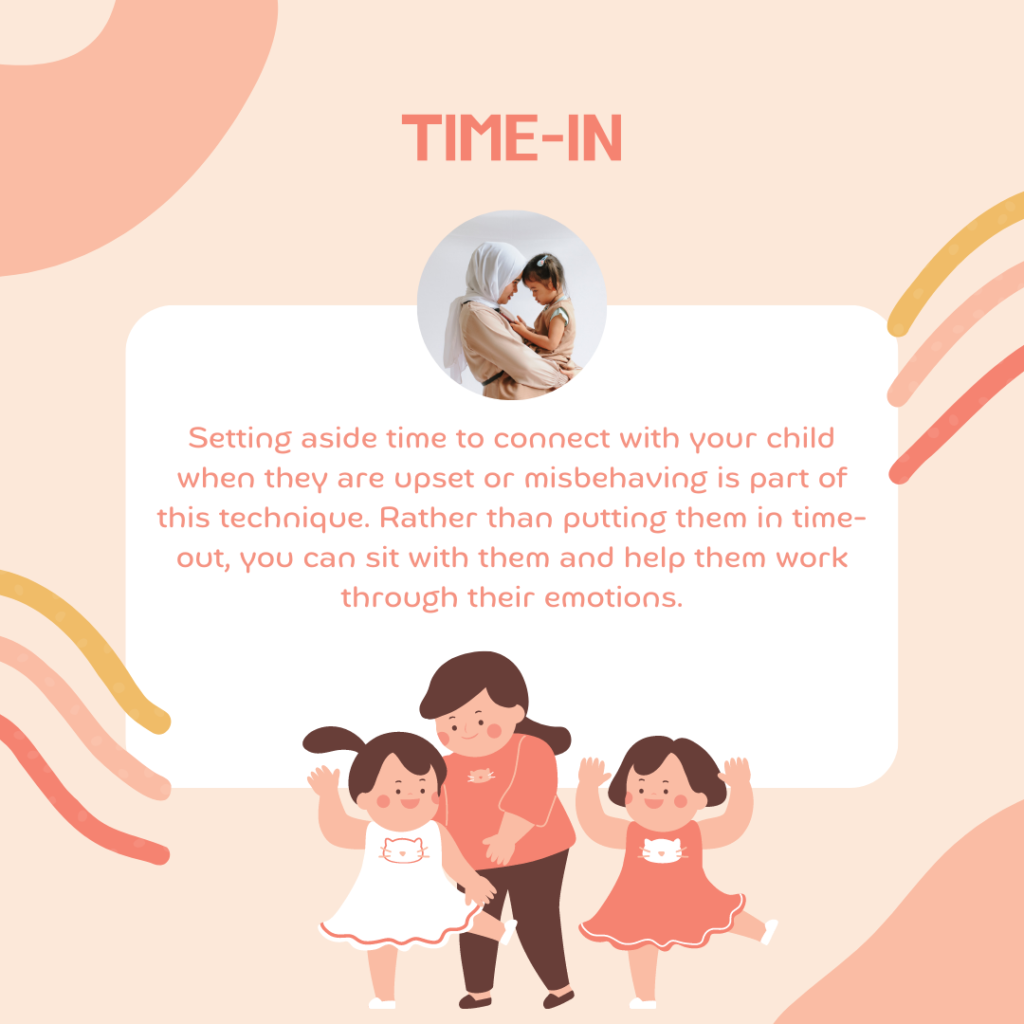
During a time-in, the parent or caregiver sits with the child and helps them calm down by offering words of comfort or physical touch. This technique can be particularly effective for children who are feeling overwhelmed, anxious, or upset.
The goal of a time-in is to help the child learn to regulate their emotions and behavior in a positive way. By providing emotional support and guidance, parents can help their children learn to self-regulate and develop emotional intelligence.
Why use Time-in?
Time-in can also be used as a way to strengthen the parent-child bond. By spending quality time together in a calm and supportive environment, parents can help their children feel loved and secure. This can help to build a strong foundation for a healthy and positive relationship between parent and child.
For time-in to be effective, it is important to use it consistently and to provide a safe and nurturing environment for the child. Using time-in as a gentle parenting discipline, parents can help their children develop strong emotional regulation skills and build positive and supportive relationships with them.
Redirection
This method entails directing your child’s attention to more positive behavior. For example, if your child is crying because they can’t get a toy at the store, you can tell them, “I know you want that toy, but we can’t get it today. Instead, let’s go look at the books. Would you like to choose a book to read together?”
Redirection is a gentle parenting discipline technique that involves redirecting a child’s behavior from a negative or inappropriate action to a positive and more appropriate one. This technique is often used with young children who may not fully understand the consequences of their actions.
For example, if a child throws toys, a parent might redirect their attention to a different activity or toy that is more appropriate for them to play with. By doing this, the parent redirects the child’s energy and attention to more positive behavior.
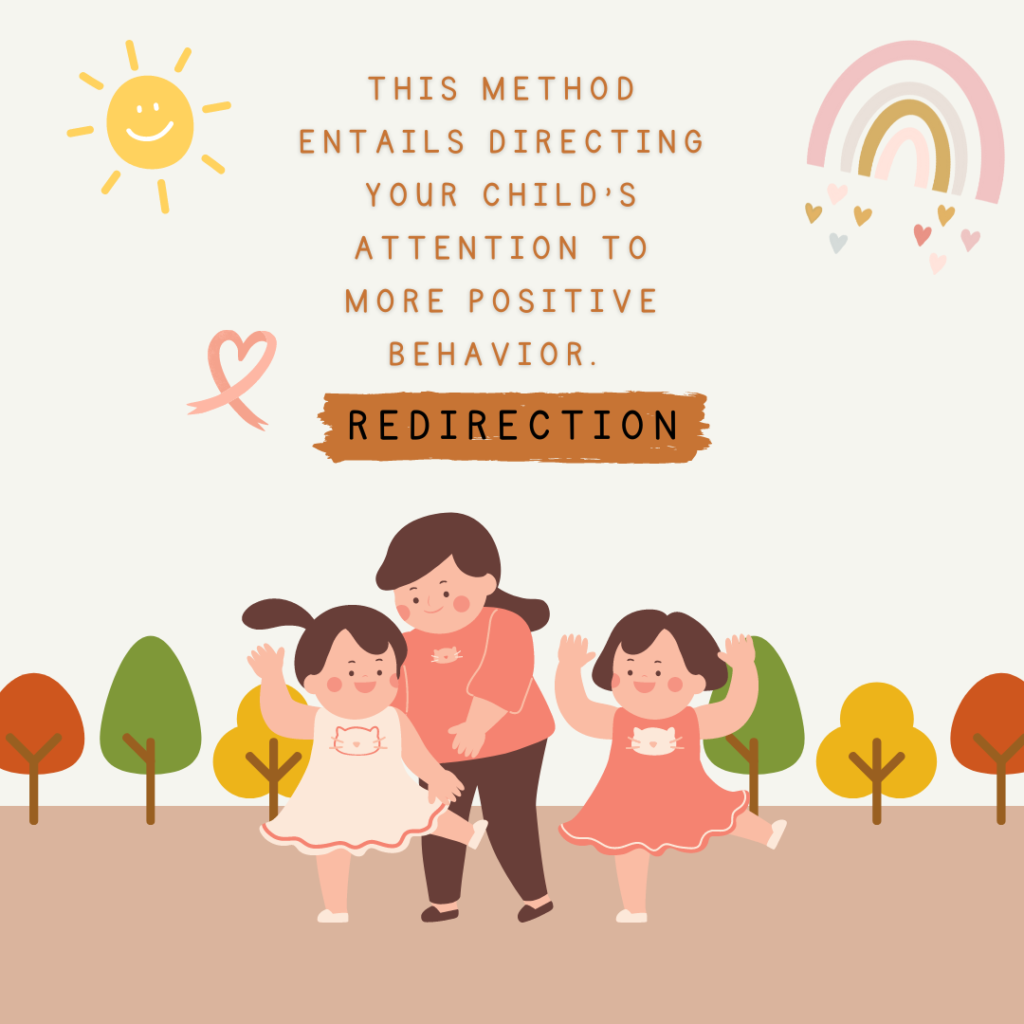
Why Redirection
Redirection can also be used to prevent negative behaviors before they even start. For example, suppose a child is reaching for a forbidden object. In that case, a parent might redirect their attention to a different toy or activity before the child can grab the forbidden object.
Redirection aims to help children learn appropriate behaviors and prevent negative behaviors from becoming habits. By redirecting a child’s attention to more positive behavior, parents can help their children develop self-control and learn to make better choices.
It is important to note that redirection should always be done in a positive and supportive manner. Parents should avoid shaming or punishing their children for negative behaviors, which can lead to resentment and a negative self-image. Instead, parents should encourage positive behaviors and redirect negative ones in a gentle and supportive way.
Setting Boundaries with Empathy
Setting limits on your child’s behavior while remaining compassionate is the goal of this technique. For example, if your child wants to watch television all day, you can tell him, “I understand that you enjoy watching television, but we also need to take breaks and do other things. Let’s watch a show together and then go outside to play.”
Setting boundaries with empathy means communicating your needs and limits to others in a way that is respectful, compassionate, and understanding of their feelings. It involves acknowledging the other person’s perspective while asserting your needs and boundaries.
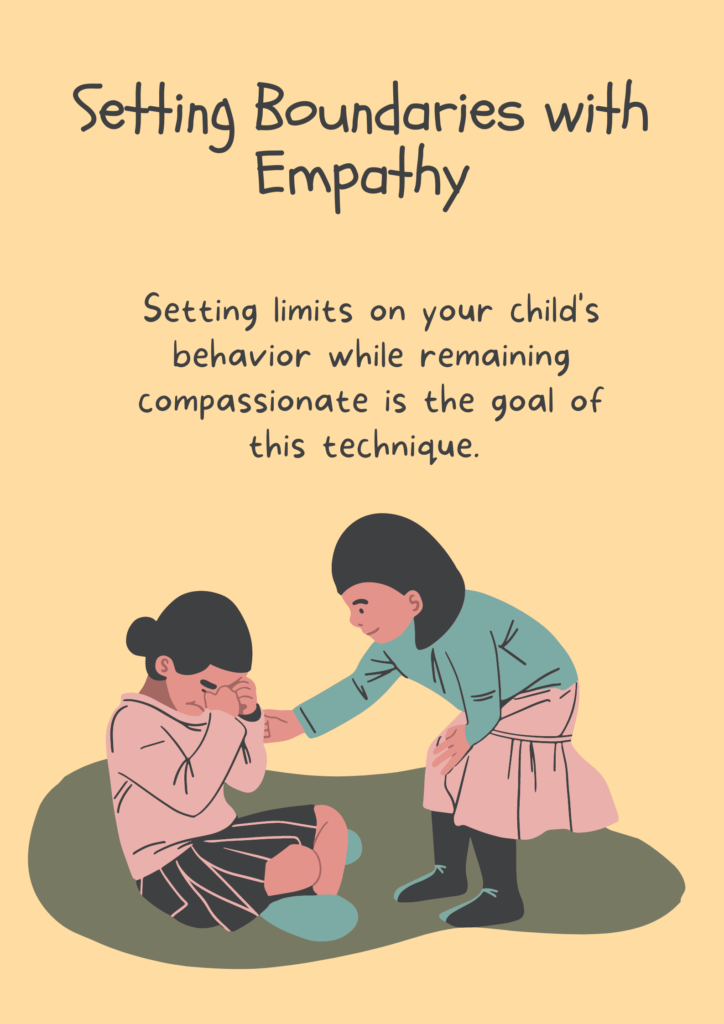
For example, if a friend constantly asks for help with their problems, you might set a boundary by saying, “I really care about you and want to support you, but I also need to take care of myself. Can we schedule a time each week to discuss your concerns so I can manage my time and responsibilities?”
When setting boundaries with empathy, it is important to communicate clearly and honestly while also remaining compassionate and understanding. It is also important to recognize that setting boundaries can be difficult and uncomfortable but that it is a necessary part of maintaining healthy relationships.
By setting boundaries with empathy, you show respect for yourself and the other person. You are communicating your needs and limits in an assertive but not aggressive way, and you are creating space for both parties to be heard and respected.
Overall, setting boundaries with empathy is an important skill for building healthy relationships and maintaining emotional well-being. It requires honesty, compassion, and assertiveness, but it can lead to stronger, more fulfilling relationships in the long run.

